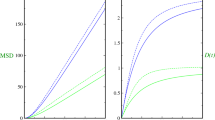Abstract
Dissipative backflow is studied in the context of open quantum systems. This theoretical analysis is carried out within two frameworks, the effective time-dependent Hamiltonian due to Caldirola–Kanai (CK) and the Caldeira–Leggett (CL) one where a master equation is used to describe the reduced density matrix in the presence of dissipation and temperature of the environment. Two examples are considered: the free evolution of one and two Gaussian wave packets and the time evolution under a constant field. Backflow is shown to be reduced with dissipation and temperature but never suppressed. Interestingly enough, quantum backflow is observed when considering both one and two Gaussian wave packets within the CL context. Surprisingly, in both cases, the backflow effect seems to be persistent at long times. Furthermore, the constant force \( \mathrm{mg}\ge 0 \) behaves against backflow. However, the classical limit of this quantum effect within the context of the classical Schrödinger equation is shown to be present. Backflow is also analyzed as an eigenvalue problem in the CK framework. In the free propagation case, eigenvalues are independent on mass, Planck constant, friction and its duration, but, in the constant force case, eigenvalues depend on a factor which itself is a combination of all of them as well as the force constant.







Similar content being viewed by others
Change history
14 August 2020
Within the context of the CL master equation, when a quantum system is initially described by the pure state given by Eq. (15) in the momentum space, the probability for obtaining a negative value in a measurement of momentum at time t, when no external interaction potential is present, is given
References
G.R. Allcock, Ann. Phys. 53, 253 (1969)
G.R. Allcock, ibid 53, 286 (1969)
G.R. Allcock, ibid 53, 311 (1969)
A.J. Bracken, G.F. Melloy, J. Phys. A: Math. Gen. 27, 2197 (1994)
A.J. Bracken, G.F. Melloy, Ann. Phys. (Leipzig) 7, 726 (1998)
M. Penz, G. Grübl, S. Kreidl, R. Verch, J. Phys. A 39, 423 (2006)
J.G. Muga, C.R. Leavens, Phys. Rep. 338, 353 (2000)
M.V. Berry, S. Popescu, J. Phys. A:Math. Theor. 39, 6965 (2006)
M.V. Berry, J. Phys. A: Math. Theor. 43, 415302 (2010)
J.M. Yearsley, J.J. Halliwell, R. Hartshorn, A. Whitby, Phys. Rev. A 86, 042116 (2012)
J.M. Yearsley, J.J. Halliwell, J. Phys.: Conference Serie 442, 012055 (2013)
F. Albarelli, T. Guaita, M.G.A. Paris, Int. J. Quantum Inf. 14, 1650032 (2016)
A. Goussev, Phys. Rev. A 99, 043626 (2019)
J.M. Yearsley, Phys. Rev. A 82, 012116 (2010)
P. Caldirola, Nuovo Cimento 18, 393 (1941)
E. Kanai, Prog. Theor. Phys. 3, 440 (1948)
A.O. Caldeira, A.J. Leggett, Phys. A 121, 587 (1983)
A.O. Caldeira, An Introduction to Macroscopic Quantum Phenomena and Quantum Dissipation (Cambridge University Press, Cambridge, 2014)
S.V. Mousavi, S. Miret-Artés, Ann. Phys. 393, 76 (2018)
A.S. Sanz, R. Martínez-Casado, H.C. Peñate-Rodriguez, G. Rojas-Lorenzo, S. Miret-Artés, Ann. Phys. 347, 1 (2014)
C.D. Richardson, P. Schlagheck, J. Martin, N. Vandewalle, T. Bastin, Phys. Rev. A 89, 032118 (2014)
S.V. Mousavi, S. Miret-Artés, J. Phys. Commun. 2, 035029 (2018)
S.V. Mousavi, S. Miret-Artés, Eur. Phys. J. Plus 135, 83 (2020)
A. Venugopalan, Phys. Rev. A 50, 2742 (1994)
A. Venugopalan, D. Kumar, R. Ghosh, Phys. A 220, 563 (1995)
S.V. Mousavi, S. Miret-Artés, Eur. Phys. J. Plus 134, 311 (2019)
S.V. Mousavi, S. Miret-Artés, Eur. Phys. J. Plus 134, 431 (2019)
I. Percival, Quantum State Diffusion (Cambridge University Press, Cambridge, 1998)
H.-P. Bauer, F. Petruccione, The Theory of Open Quantum Systems (Oxford University Press, Oxford, 2002)
Acknowledgements
SVM acknowledges support from the University of Qom and SMA support from the Ministerio de Ciencia, Innovación y Universidades (Spain) under the Project FIS2017-83473-C2-1-P. We would like to thank the referees for providing us very important and critical comments.
Author information
Authors and Affiliations
Corresponding author
Rights and permissions
About this article
Cite this article
Mousavi, S.V., Miret-Artés, S. Dissipative quantum backflow. Eur. Phys. J. Plus 135, 324 (2020). https://doi.org/10.1140/epjp/s13360-020-00336-5
Received:
Accepted:
Published:
DOI: https://doi.org/10.1140/epjp/s13360-020-00336-5




